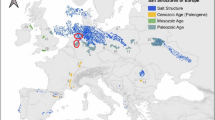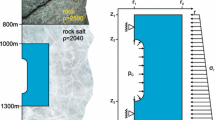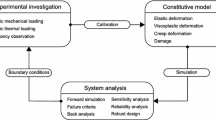Abstract
Salt cavities for storage of natural gas in bedded or domal salt structures are an important element of today’s and tomorrow’s energy supply management. In Germany the mechanical design of salt cavities has a history of more than 35 years. Based on laboratory investigations, physical modelling, analytical or much more importantly numerical simulations and last but not least field experiments and operational experience, knowledge about salt mechanics and salt cavern load bearing behaviour has increased significantly. This scientific-technical improvement corresponds very well with the development of individual cavern sizes
starting at a volume of 10,000 m3 and rising to a Million m3 of natural geometric storage with optimal geotectonic conditions.
The presentation first gives an overview on the development of salt cavity design and an insight into today’s state of the art designs. Special items include the geo-mechanical characteristics of storage cavities and principle safety demands for their design as well as recent design concepts and a way to provide geotechnical proof of safety with specialized criteria. Furthermore, the main aspects of lab testing and physical modelling are considered. Here damage to salt rock and its numerical characterization are of significant importance for further development. Based on numerical simulations using commercial or specialized software, safety analysis and cavern design, with respect to site specific defined criteria, lead to admissible values for cavern configuration and operation parameters.
Additionally, based on decades of existing experience, a method for designing salt caverns for high frequency cycling of storage gas is introduced using long – or short-term historic operational data. Material parameters and the deformation behaviour are adjusted to cavern convergence data from sonar surveys with reference to multicyclic laboratory tests of rock salt cores. Using the novel Lux/Wolters constitutive material law, where rock salt is treated as “material with memory” by a modified Lubby2 approach, the real behaviour of rock salt deformation can be reliably described. For multicyclic storage operations additional thermal stresses have to be taken into account for analysis of cavern integrity. A numerical thermodynamic simulation model is used to forecast related temperature changes. Cavern design in this case is based on thermo-mechanic coupled simulations.
Access this chapter
Tax calculation will be finalised at checkout
Purchases are for personal use only
Preview
Unable to display preview. Download preview PDF.
Similar content being viewed by others
References
Sedlacek, F.: Untertage-Gasspeicherung in Deutschland. Erdöl-Erdgas-Kohle 128 Jg.Heft 11 (2012)
Lux, K.H.: Gebirgsmechanischer Entwurf und Felderfahrungen im Salzkavernenbau. F. Enke Verlag (1984)
Lux, K.H., et al.: Neue Aspekte zum Tragverhalten von Salzkavernen und zu ihrem geotechnischen Sicherheits-nachweis. Erdöl Erdgas Kohle 3/4 (1999)
Lux, K.H., et al.: Erhöhung der Wirtschaftlichkeit von Speicherkavernen durch Anwendung eines neuen Entwurfs- und Nachweiskonzeptes. Erdöl Erdgas Kohle 6/7/8 (2002)
Lux, K.H.: Zum langfristigen Tragverhalten von verschlossenen solegefüllten Salzkavernen – ein neuer Ansatz zu physikalischer Modellierung und numerischer Simulation. Erdöl Erdgas Kohle 11 (2005); 4/11 (2006) (2005/2006)
Lux, K.H.: Design of Salt Cavities for Storage of Crude Oil, Natural Gas as well as Compressed Air – Some Fundamental Geomechanic Aspects for Construction, Operation and Abandonment. Special Publication on UGS, British Geological Society (2007)
Wolters, R., Lux, K.H., Düsterloh, U.: Evaluation of Rock Salt Barriers with Respect to Tightness: Influence of Thermomechanical Damage, Fluid Infiltration and Sealing/Healing. In: 7th Conference on the Mechanical Behaviour of Salt, Paris, April 16-19 (2012)
Lerche, S.: Kriech- und Schädigungsprozesse im Salinargebirge bei mono- und multizyklischer Belastung. Ein Beitrag zur Weiterentwicklung der Analysemöglichkeiten und der geotechnischen Nachweisführung im Bereich der Salzmechanik mit Anwendung auf Fragestellungen aus dem Salzkavernenbau. Schriftenreihe Lehrstuhl für Deponietechnik und Geomechanik TU Clausthal 18 (2012)
Lux, K.H., Dresen, R.: Design of Salt Caverns for High Frequency Cycling of Storage Gas. In: 7th Conference on the Mechanical Behaviour of Salt, Paris, April 16-19 (2012)
KBB Underground Technologies (2005), http://www.kbbnet.de
Lux, K.H., Düsterloh, U.: Gesteinsmechanische Untersuchungen an Salinargesteinen und ihre Bedeutung für die wirtschaftliche Optimierung und den multizyklischen Betrieb von Kavernenspeichern, Teil 1: Mechanische Untersuchungen. Erdöl Erdgas Kohle 11 (2010), Teil 2: Hydraulische Untersuchungen. Erdöl Erdgas Kohle 2 (2011) (2010/2011)
Lux, K.-H., Wermeling, J., Bannach, A.: Determination of Allowable Operating Pressures for a Gas Storage Cavern Located Close to a Tectonic Fault. Technical Conference Paper, SMRI – Fall 2004 Conference, Berlin (2004)
Düsterloh, U., Lerche, S., Lux, K.H.: Damage and Healing Properties of Rock Salt-Long term Cycling Loading Tests and Numerical Back Analysis. In: Proc. 3rd Sino-German Conference, Goslar (2013)
Heusermann, S., Lux, K.H., Rokahr, R.B.: Entwicklung mathematisch-mechanischer Modelle zur Beschreibung des Stoffverhaltens von Salzgestein in Abhängigkeit von der Zeit und von der Temperatur auf der Grundlage von Laborversuchen. Schlussbericht zum Forschungsvorhaben ET 2011 A, Institut für Unterirdisches Bauen, Universität Hannover (1982)
Hou, Z.: Untersuchungen zum Nachweis der Standsicherheit für Untertagedeponien im Salinargebirge. Schriftenreihe Lehrstuhl für Deponietechnik und Geomechanik TU Clausthal 9 (1997)
Hou, Z.: Geomechanische Planungskonzepte für untertägige Tragwerke mit besonderer Berücksichtigung von Gefügeschädigung, Verheilung und hydromechanischer Kopplung. Schriftenreihe Lehrstuhl für Deponietechnik und Geomechanik TU Clausthal 13 (2002)
Kachanov, L.M.: Introduction to Continuum Damage Mechanics. Martinus Nijhoff Publisher (1986)
Brouard, B., Bérest, P., Karimi-Jafari, M.: Onset of Tensile Effective Stresses in Gas Storage Caverns. In: Proc. SMRI Fall 2007 Technical Conference, Halifax, Canada (2007)
Author information
Authors and Affiliations
Editor information
Editors and Affiliations
Rights and permissions
Copyright information
© 2013 Springer-Verlag Berlin Heidelberg
About this paper
Cite this paper
Lux, KH. (2013). Recent Developments in Geotechnical Design of Natural Gas Storage Cavities Regarding Physical Modelling as Well as Numerical Simulation. In: Hou, M., **e, H., Were, P. (eds) Clean Energy Systems in the Subsurface: Production, Storage and Conversion. Springer Series in Geomechanics and Geoengineering. Springer, Berlin, Heidelberg. https://doi.org/10.1007/978-3-642-37849-2_35
Download citation
DOI: https://doi.org/10.1007/978-3-642-37849-2_35
Publisher Name: Springer, Berlin, Heidelberg
Print ISBN: 978-3-642-37848-5
Online ISBN: 978-3-642-37849-2
eBook Packages: EngineeringEngineering (R0)




